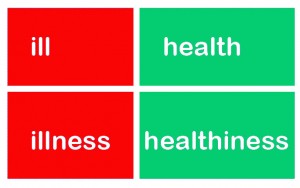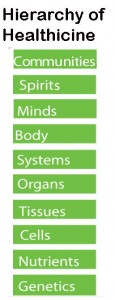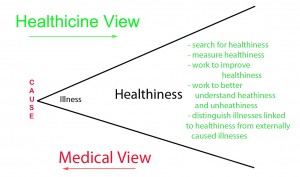For centuries, medical experts and philosophers have attempted to define health, with little success. We might forgive Hippocrates for describing health “as a delicate balance of four fluids: blood, yellow bile, black bile, and phlegm, with imbalance leading to illness,” or the traditional medical experts of China for describing health as “the opposing forces of yin and yan, the notion of five elements (wood, fire, earth, metal and water), and the concept of chi”. In 1949, the World Health Organization defined health, as “a complete state of physical, mental and social well-being, and not merely the absence of disease or infirmity“, and since then their definition has been often criticized and widely ignored. It has not lead to any success in improving health nor fighting illness. Since that time, there have been few isolated attempts to define health, and all have been largely ignored by the medical and other professions.
Why can’t we create a useful definition of health? The answer is actually quite simple. It’s due to a simple misunderstanding, which is illustrated in this diagram. We need to understand four words, because one of them is largely missing in both ancient, and modern medicines.
 The four words are ill and illness, and health and healthiness.
The four words are ill and illness, and health and healthiness.
Let’s think about illness for a moment. What is the difference between ‘ill’ and illness? An ill, as a noun, is a problem or a misfortune, an evil, or harm. How could you wish him ‘ill’. Ill cannot be measured, nor improved upon.
An illness, on the other hand is a specific case. An illness can be diagnosed, measured, treated, and often cured. An illness has a cause, and a prognosis.
It’s the same with health. Health is a general concept, without specific substance. You might say that you ‘lose health’ when you get sick, and regain it when your illness is cured. The health that was lost cannot be measured, only the illness can be measured. Health cannot be measured, and as a result, it cannot be improved. Health, it seems, is not susceptible to medical, or any other technology.
There is no definition of ‘health’ that can be used to improve ‘healthiness’. To improve healthiness, to improve any specific aspect of health.
We need definitions of healthiness.
A healthiness is a specific measurable instance of health. A healthiness can be measured, it can be improved, and it can be demonstrated to have been improved. Your physical healthiness, your mental healthiness, your dietary healthiness can be measured and improved. But when doctor’s, and courts of law, search for ‘mental health’ today, they are actually searching for ‘mental illness’.
Once we understand that a healthiness is a specific instance of health, we can proceed to define many healthinesses, to learn to measure them and to improve on them. We can use current measures of healthiness, to test improvement techniques, and re-evaluate our measures of healthiness, and improve on our measurement techniques, and to improve our healthiness improvement techniques.
It is interesting to note that the word ‘illness’ is commonplace, but the word healthiness does not appear in dictionaries, except perhaps as a note in the definition of health. Many dictionaries and references refer ‘healthiness’ directly to health, as if the two concepts were the same. This leads to many confusions.
We can measure a healthiness, but we cannot measure health. Let’s look more closely at the concept of measuring healthiness, to gain a better understanding.
What might be a measure of healthiness? Surely not height, nor weight, nor any scalar measurement. Individual measurements of height, width, or weight, for example give no indication of health. The vital signs – blood pressure, respiration rate, body temperature and pulse are measures of danger, of risk, not measures of healthiness.
BMI, the ratio between height and weight, is a crude indicator of healthiness. BMI can be a weak measure of healthiness, but it is a useful measure. Health is slow. BMI does not ‘attack’ like an illness, it changes slowly, often only with considerable effort.
BMI as a measure of healthiness illustrates an important principle. We cannot measure a healthiness as any single measurement. The same is true of illness. No single measurement can be used to diagnose an illness. Traditionally, an illness is diagnosed by at least three observations, or measurements of signs and symptoms. Sometimes, one of the measurements is time. A measured instance of high blood pressure does not indicate hypertension. Hypertension exists when abnormally high resting blood pressure persists over time.
A healthiness, like an illness, requires several measurements, and an evaluation of the relationship between those measurements. Weight divided by height gives BMI. But how can we tell if the result is more, or less ‘healthy’?
A measure of healthiness is a relationship between different factors, and like many Facebook relationships, “It’s complicated”. Every relationship between two or more health factors, measurements of health factors, has a healthy goal. This gives rise to a very point about measuring healthiness.
Every measure of healthiness can be expressed as a percentage. The calculation of BMI gives a number, but that number, alone, is not a useful measure of healthiness. BMI can only indicate a level of healthiness when it is compared to a goal. If your BMI is exactly at your BMI goal, then your BMI healthiness is 100 percent. If your BMI is below your BMI goal, then your BMI healthiness is less than 100 percent, but if your BMI is above your BMI goal – your BMI healhtiness is also less than 100 percent. Note: you can change your level of BMI healthiness by changing your personal BMI goal.
This leads to another important concept of health, that is little studied by medical researchers. The concept of ‘unhealthiness’. If a healthiness is a measurable instance of health, what is an unhealthiness? Is it measurable?
Is unhealthiness a broken arm, or a case of measles, or a cancer, an unhealthiness? No. The first is an injury, sometimes called an illness. The next two are clearly illnesses, not unhealthiness.
If you are as smoker, your smoking is an unhealthiness. If you are obese, your weight is an unhealthiness (and probably your diet as well). Sometimes, and illness is directly caused by an unhealthiness – scurvy is caused by an unhealthy diet. It can only be cured with health.
An unhealthiness is a negative healthiness that can be changed. “That can be changed” is an important detail. If it cannot be changed, it is a fact of life. It might be a disability, or a natural feature. It is only an unhealthiness if there is potential for change, for improvement.
If your BMI is 27, and your BMI goal is 25, your level of BMI healthiness is 25/27, about 93 percent. Your level of BMI unhealthiness is the difference – about 7 percent. Unhealthiness is a measure of the improvement you might make in a specific aspect of healthiness. It too can be expressed as a percentage.
An unhealthiness is room for improvement in healthiness, room for improvement in health. If there is little room for improvement, maybe it’s time to examine and measure a different aspect of healthiness. If there is no room for improvement in healthiness, the subject might be dead.
We cannot measure ‘health’, we can only measure specific incidences of healthiness, which also give us specific measurements of unhealthiness. Note: We might also measure a specific unhealthiness, as a percentage, and thus be able to calculate the inverse – the level of that specific healthiness.
How many healthinesses exist? How many healthinesses do we need to measure, to get a true picture of health? But there is no answer. We cannot count the number of illnesses that exist, and we cannot count the number of ‘healthinesses’ that we might measure. Mathematically, the number of healthinesses is higher than the number of illnesses. It is possible to have two, three or even more illnesses at once. But we have thousands of different aspects of healthiness.
How many? Can we get any idea how many different healthinesses might exist? How broad and how deep is health? Yes, we can.
Healthiness has two main dimensions, physical aspects and process aspects. BMI is a physical measure of physical healthiness. BMI can be measured. A goal can be created, and the subject can initiate actions (or non-actions, not eating specific foods or quantities) in attempts to attain the goal. Sleep is a process that can be a base for a process based healthiness. How much sleep do you get every day, on average? What is your healthy sleep goal? How unhealthy is your current sleep profile, how much room do you have for improvement.
 The physical aspects of health can be arranged into the hierarchy of healthicine, beginning with genetics and nutrition, and expanding through cells, tissues, organs, bodily systems, body, minds, spirits, and communities. There are many individual components at every level. Every individual component has many possible measures of healthiness. There are also components and processes that exista t intersections or cross the boundaries of the hierarchy. BMI is body healthiness. Sleep healthiness covers many layers – body, mind, and spirit. At each layer in the hierarchy of healthicine, there are many individual physical components of health. Each can be measured in relation to others, to create a measure of healthiness. Of course some are more important than others – but we can’t learn which until we begin to measure, to study and improve our measurements.
The physical aspects of health can be arranged into the hierarchy of healthicine, beginning with genetics and nutrition, and expanding through cells, tissues, organs, bodily systems, body, minds, spirits, and communities. There are many individual components at every level. Every individual component has many possible measures of healthiness. There are also components and processes that exista t intersections or cross the boundaries of the hierarchy. BMI is body healthiness. Sleep healthiness covers many layers – body, mind, and spirit. At each layer in the hierarchy of healthicine, there are many individual physical components of health. Each can be measured in relation to others, to create a measure of healthiness. Of course some are more important than others – but we can’t learn which until we begin to measure, to study and improve our measurements.
The hierarchy of healthicine also contains many layers of process. As we rise up the hierarchy, the processes become more and more complex. The basic processes of life, and of health are growth, which includes reproduction and evolution, and healing. Life forms soon developed processes that sense and react to our environment, exercising our choices, and ourselves, resting, relaxing and recovering, as well as communicating and cooperating. As life forms become more complex, more complex processes arise. The circulation of blood, for example, is an extremely complex process that facilitates both growth, healing, and many other processes.
Does anyone measure healthiness today? Of course. There are lots of organizations today, and lots of techniques for measuring healthiness. We, and these organizations can ‘create’ measurements of healthiness, thus creating new healthinesses to be measured. All that is required is a healthiness goal – and a way to measure status and progress toward the goal. But today, there is no overall understanding of the concepts of healthiness and the concepts of unhealthiness. The word healthiness is not in the dictionary, and it is not used in any scientific research papers.
We create illnesses as well. When we look closely at the concept of illness – illnesses are invisible. They do not actually exist. An illness is the name we give when a cause intersects with, or causes specific signs and symptoms. We can see the cause – the bacteria, or the dietary deficiency, or the toxic chemical. We can see the results – the signs and symptoms of illness. But the illness only exists in the intersection of the causes and the symptoms. The cause can exist without the illness. The symptoms can exist without the illness. The illness only exists at the intersection.
We know this, about illness, but we don’t study healthiness, so we don’t know much about healthiness. We have no understanding of the concepts of healthiness.
When your doctor, or your health coach, measures your BMI, they are measuring your healthiness. Adolphe Quetelet created and refined BMI in the mid-1800s. Quetelet didn’t create it to measure healthiness, instead it was created to measure the unhealthiness of populations, and their tendency towards illness. BMI was not intended for use by individuals, because it does not contain individual goals. But, with an individual goal, it can be used as a measure of individual healthiness.
Most measurements of healthiness today are directed against illness, not towards improvements in health. We can change that, now that we understand the of healthiness, and of unhealthiness. Once we do that, we will know that the definition of ‘health’ is largely irrelevant.
But what about ‘overall healthiness’, how might we measure that? In order to measure overall healthiness, we need to be aware of a fundamental distinction between diagnosing illness and measuring healthiness. When we diagnose an illness, our goal is to eliminate possibilities, to zero in on the illness by asking specific questions that focus our attention.
In this diagram, the medical view follows the red arrow, to focus signs and symptoms on the illness, and sometimes, on the cause of the illness.

A healthicine view searches for healthiness, looking in the opposite direction. But it doesn’t look for a single healthiness and it doesn’t look for a single cause of healthiness. When we search for health, for overall healthiness, we need to widen our perspective, widen our view.
It is not logical to ‘narrow’ our view to find health. Medicine searches for illness by narrowing the view to a single illness. But using this technique to measure health is a misunderstanding. An illness is like a tree. Health, overall health, is like a forest, like a jungle, like the garden of Eden. If you want to understand a forest, a jungle, even a garden, you need techniques that broaden your view, not techniques that focus it.
If want to know if a student is ready to graduate, we don’t try to ‘zero in’ on the question. We ask the student a large number of questions. The questions cover the area of study. If the patient passes the test, they get a mark, a percentage – and a decision is made about their success. Sometimes, there are errors, but the more questions we ask, the more accurate our assessment becomes. It’s the same with overall healthiness.
We can learn which areas of healthiness have more opportunity for improvement, by studying many factors, and comparing them. Developing techniques to measure and improve healthiness is more complex than searching for a diagnosis, and then searching for a cause, because health is about choices, about opportunities, not about limitations and risks.
We might, over time, learn which aspects of healthiness are more important, and which are less important, but I suspect that time is far away. At present, even studies that might be viewed as measures of healthiness, tend to be used to predict and avoid illness, not to improve healthiness.
to your health, tracy
Tracy is the author of two books about healthicine:


